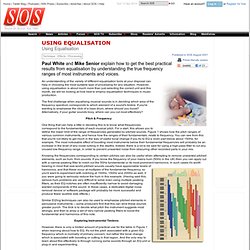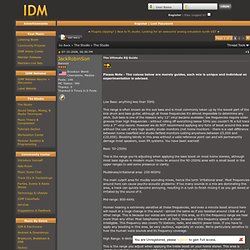

Handy EQ Reference. Advanced effects: Reverb masterclass. Audio How To: get professional sounding mix. Music Mixing Tips and Articles. Sharpen your music mixing skills with the knowledge and techniques you'll discover below.

The art of the great mixdown can seem at times like magic, and indeed it does involve some pretty subtle manipulations and cunning aural trickery. The real secret as you probably know by now is no secret at all: only knowledge and practice will improve your game. Knowledge and practice act as the two pillars upon which your mixing abilities rest. You should therefore always strive to learn more about the gear you use and add new techniques to your audio mixing skillset. The mixing knowledge we share with you below will provide you with insights and techniques to apply to your own work. Remember, if it sounds great, it is great. Dive into the music mixing articles below right now and then get back in the mix and work it like an obsessed audio scientist. We look forward to hearing your results! Current mixing articles...
"4 Kick and Bass EQ tips for tighter mixes... " USING EQUALISATION. Technique : Effects / Processing Paul White and Mike Senior explain how to get the best practical results from equalisation by understanding the true frequency ranges of most instruments and voices.

An understanding of the variety of different equalisation tools at your disposal can help in choosing the most suitable type of processing for any situation. However, using equalisation is about much more than just selecting the correct unit and this month, we will be looking at how best to employ equalisation techniques in music production.
The first challenge when equalising musical sounds is in deciding which area of the frequency spectrum corresponds to which element of a sound's timbre. If you're wanting to emphasise the click of a bass drum, where should you boost? Pitch & Frequency One thing that can help a little in deciding this is to know what frequencies correspond to the fundamentals of each musical pitch. Exploring Instrumental Timbres Setting EQ Gain Equalisation Or Enhancement? The Ultimate EQ Guide. Please Note - The values below are merely guides, each mix is unique and individual so experimentation is advised.

Low Bass: anything less than 50Hz This range is often known as the sub bass and is most commonly taken up by the lowest part of the kick drum and bass guitar, although at these frequencies it's almost impossible to determine any pitch. Sub bass is one of the reasons why 12" vinyl became available: low frequencies require wider grooves than high frequencies - without rolling off everything below 50Hz you couldn't fit a full track onto a 7" vinyl record. However we do NOT recommend applying any form of boost around this area without the use of very high quality studio monitors (not home monitors - there is a vast difference between home nearfield and studio farfield monitors costing anywhere between £5,000 and £20,000). Boosting blindly in this area without a valid reference point can and will permanently damage most speakers, even PA systems.
Professional Equalizer Mixing Techniques Simplified Part 1. Interactive Frequency Chart - Independent Recording Network. Pro Audio, Live Sound, Music Recording and Live Post for Audio Pros.